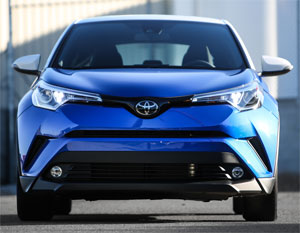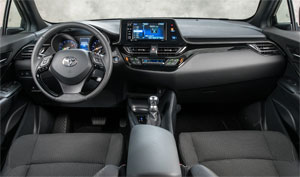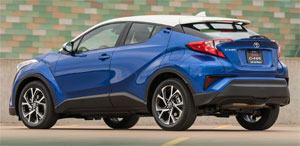2018 Toyota C-HR
The upside of the Scion brand’s demise is that things are getting a little more exciting at corporate parent Toyota. This re-branded C-HR, or coupe high rider, gives Toyota a much-needed entry into the subcompact utility category, and one with looks that are quite out there. But, does C-HR also deliver meaningful utility, or is it all about funky style?
First things first, the 2018 Toyota C-HR does indeed give Toyota another entry into what is the fastest growing vehicle choice today, utility vehicles. It slides under the Rav4 in their car-based crossover lineup. First revealed in concept form at the 2014 Paris Motor Show, the CH-R also indicates a bolder direction in overall Toyota design.
The production model clearly resembles that concept, but is far from an exact copy. The front end sets a very confident tone; while deep-cut body lines point towards the C-pillars, where there’s both a floating roof design and high-mounted door handles.
From there, an almost horizontal back glass leads to a hacked-off rear with its own aggressive lines. Wheelbase is less than an inch shorter than the RAV4, yet there’s over a foot difference in overall length. 18-inch alloys and 50-Series tires are standard.
 There are plenty of aero treatments that the kid’s love these days, including diffuser, spoiler, wheel spats, and even “vortex generators”.
There are plenty of aero treatments that the kid’s love these days, including diffuser, spoiler, wheel spats, and even “vortex generators”.
Those high-mounted door handles actually work great. But, do yourself a favor and skip the white roof option; unless you’re going for the taxicab look.
No all-wheel-drive for now, front-wheel-drive only. No factory turbo either, as those front wheels get power from a naturally aspirated 2.0-liter I4 good for 144–horsepower and 139 lb-ft. of torque. Toyota is leaving it to the aftermarket to add more.
Unfortunately, it’s CVT only for tranny duties.
But not so fast; that CVT does a good job of delivering the moderate power smoothly, and CVT-induced engine noise is relatively minor here, as is noise in general.
It’s also has a very solid feeling for a small ute, riding on the Toyota Prius’ recently updated New Global Architecture chassis. Handling is quite good, as it remains very flat in corners, urging you to push it harder than you probably should; though there’s not enough power here for you to really get yourself into too much trouble.
Through the rolling Hill Country around Austin, Texas, we found steering to be very quick, with good feedback through the wheel, as well as through the brake pedal.
 Things are very sporty in both look and feel inside, with a hip Scion-like touchscreen audio display, but no Satellite radio, Apple CarPlay, or Android Auto.
Things are very sporty in both look and feel inside, with a hip Scion-like touchscreen audio display, but no Satellite radio, Apple CarPlay, or Android Auto.
Likewise, gauges are more Scion than Toyota; with a 4.2-inch TFT multi-instrument display that gives lots of info including a G-Force monitor.
Front seat space is plentiful and are sufficiently comfortable. All controls are within easy reach. Rear seats are claustrophobic. Not a lot of space, and very little window to see out of; though there are belts for 3 back here.
Like many sub-compact crossovers, cargo space is just adequate; 19.0 cubic-ft. puts it slightly under the Honda HR-V, but much higher than the Mazda CX-3. Folding the seatbacks takes it to more acceptable 36.4 cubic-ft.
Now, as for what this Coupe High Rider crossover is not; well, despite its slick shape, it’s not a coupe, more of a 5-door hatchback. And it doesn’t ride overly high either, with just 5.9-inches of ground clearance. And it’s certainly not a traditional crossover without all-wheel-drive. So what’s left? A lot of target marketing and a respectable amount of fun.
 No skimping on safety features however. Toyota’s unfortunately-named Safety Sense P, with Pre-Collision System and Full-Speed Range Dynamic Radar Cruise Control, is standard, as are 10-airbags.
No skimping on safety features however. Toyota’s unfortunately-named Safety Sense P, with Pre-Collision System and Full-Speed Range Dynamic Radar Cruise Control, is standard, as are 10-airbags.
Government Fuel Economy Ratings are 27-City, 31-Highway, and 29-Combined. For a better than average Energy Impact Score of 11.4-barrels of yearly oil use with 5.0-tons of CO2 emitted.
As for the sticker prices? Base XLE trim starts at $23,460; XLE Premium, at $25,310. That puts it above the Mazda3, Honda HR-V, and Nissan Juke; however, both models are very well equipped, and without options to hike that price up further.
In today’s “multi-culti” world, where we try to combine the best attributes of all cultures; the 2018 Toyota C-HR tries to put crossover practicality into a conglomeration with youthful style and peppy performance; and for the most part succeeds very well.
But still, it’s a form over function piece that much like the Nissan Juke, will appeal mostly to city-dwelling urban adventurers who need an easy to park ride with more flexibility than the typical compact. But, even without all-wheel-drive, that may be enough to give the Scion faithful an easy entry into the “Mother Brand” and make this high ridin’ coupe a hit for Toyota.
Specifications
- Engine: 2.0 liter
- Horsepower: 144
- Torque: 139 lb-ft.
- EPA: 27 mpg city / 31 mpg highway
- Energy Impact: 11.4 barrels of oil/yr
- CO2 Emissions: 5.0 tons/yr
2024 Polestar 2
More Range And More Power For The Polestar 2
Volvo is well on their way to making the transition to an all-electric brand, but their sister-brand Polestar is already there. Now, we’ve spent lots of time in their all-wheel drive, five-door Polestar 2, having tested it in 2021, and a year later when a two-wheel drive version arrived. But, EV updates are coming quickly. So, let us be your guide for all that’s new with the Polestar 2.
While we are driving more EVs than ever, we’ve also been spending a lot of time recently circling back to ones we’ve previously tested. As in this new era of electrified vehicles, significant updates are arriving quickly, with R&D investments increasing and retrofitting them easier than ever. This is often done through software updates that can even be accomplished over the air. For 2024, the Polestar 2 has indeed gotten some software updates, but some physical ones as well.
Clearly aimed directly at Tesla’s Model 3 when it arrived; the Polestar 2’s build quality was vastly better, but range definitely came up short. So, addressing that was priority No. 1; and for ’24 the Polestar can travel up to 20% farther than before while consuming 9% less energy, and when it comes time to charge it back up, it can do that 34% faster too.
Range in the Single Motor version increases from a max of 270 to 320 miles thanks to a larger 82-kWh battery pack, and that solitary motor now powers the rear wheels, not the front wheels. It’s also bigger, coming in at 220 kW compared to the previous 170 kW front-wheel drive version, going from 231 to 299 horsepower.
Dual Motors keep the same 78-kWh battery, but still sees a boost from 260 to 276 miles and takes advantage of the larger rear motor for a new combined 310-kW output with 421 horsepower. Our test car has the added Performance Pack, which uses an additional 35 kW to deliver 455 horsepower and 546 lb-ft of torque, though max range drops to just 247 miles.
The new battery in rear-drive 2s will also charge faster, now accepting up to 205 kW for an 80% charge in 20 minutes; max for dual-motors stays at 155 kW, which puts an 80% charge at 34 minutes. Using 32 kWh of electricity per 100 miles, the Dual Motor earns a good efficiency rating.
The [Polestar] 2 has always been one of the most enjoyable EVs to drive, even more so now with that additional power coming from the rear motor.
Unfortunately, extremely cold temperatures kept us from seeing that increased range, as we were only on pace for about 194 miles in our test.
The 2 has always been one of the most enjoyable EVs to drive, even more so now with that additional power coming from the rear motor. And especially when equipped with the Performance Pack as it not only includes more power, but adds 20-inch forged wheels, upgraded brakes, and adjustable Ohlins Dual Flow Valve performance dampers. It greatly improves handling prowess without affecting ride quality, and is easily worth the $5,500 charge if you at all enjoy driving.
Even on a 20-degree track day there was plenty of grip through our handling course. No understeer or oversteer, and lots of feedback through the wheel. There was a nice, strong launch off the line that properly planted us firmly in the seat, and rocketed us to 60 in 4.5 seconds. Power delivery stayed pretty intense up until about 80 mph when there was a definite tapering off. Still, it was a 13.4-second quarter-mile at 102 mph; smooth, quiet, and stable the whole way.
When this car debuted, its Google-based infotainment setup was a novelty, but since then, more and more manufacturers are just “Googling it” so it doesn’t seem out of place at all. The wireless phone charger is easy to access, and there’s a great Harmon/Kardon sound system and panoramic sunroof to enhance the in-cabin experience. Exteriors have also been enhanced with a smooth grille insert and new wheel choices.
Hatchback practicality means 14.3 cu-ft of easy to access cargo space with split-folding seatbacks for longer items and expanding the space to 38.7 cu-ft. Plus, there’s even a sizeable storage bin up front under the hood.
Single Motor Polestar 2 pricing now starts at $51,300, with Dual Motors starting at $56,700; topping out at $64,400.
For a car manufacturer that hasn’t even been around for a decade yet, Polestar has kept itself busy, totally transforming their latest model in just a few years, making the 2024 Polestar 2 even more appealing. They are certainly off to a good start, and with a host of Polestars just over the horizon, including some all-important utility vehicles, this star will be shining even brighter.
Specifications
As Tested
- Motor Setup: Dual Motor
- Horsepower: 455
- 0-60 mph: 4.5 seconds
- EPA Range: 247 miles
- Efficiency : 32 kWh / 100 miles
- Battery Size: 78-kWh
- Torque: 546 lb-ft
- 1/4 Mile: 13.4 seconds at 102 mph
- MW Test Loop: ~ 194 miles
- Peak Charging Rate: 155 kW











































